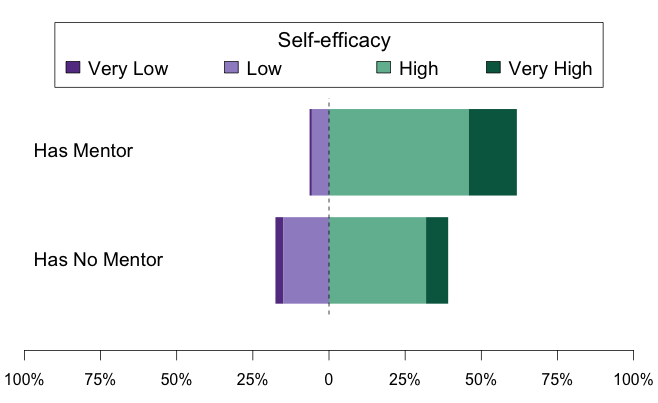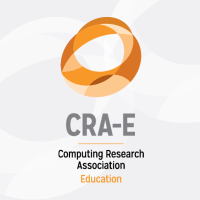Graduate Students Without Versus With a Mentor Report Lower Self-Efficacy

While almost all computing graduate students have advisors, recent CERP data indicate many of those students do not have a mentor. Specifically, 17% of a sample of graduate students enrolled in computing programs (sample N = 2,617) indicated they did not “have a mentor with whom [they] have an ongoing relationship, and who provides [them] advice and assistance in advancing in [their] career.” The graphic above presents evidence toward a potential implication of not having a trusted mentor as a graduate student: relatively low self-efficacy. Self-efficacy refers to beliefs about one’s ability to plan for and execute steps necessary for future success. Indeed, the current analysis indicates students without a mentor report lower self-efficacy in their computing career track than students with a mentor, p ≤ .001.
Notes. 2,617 graduate students from universities across the U.S. responded to CERP’s Fall 2015 Graduate Student Survey, and indicated whether or not they had a mentor through the following question: A mentor is someone with whom you have an ongoing relationship, and who provides you advice and assistance in advancing in your career. Among the people below, who do you consider to be a mentor? Response options included the following: A professor within my department (not my advisor), My advisor, A professor at my college/university who is outside of my department, An individual I met through a formal mentoring program sponsored by an outside organization, Someone else, No one.
The following five items were used to calculate a composite measure of self-efficacy (Cronbach’s alpha =.83): I am confident that I can… become an expert in my field, complete my department’s milestones towards earning my degree in a timely manner, publish in the top journals in my field, discuss theory with senior members of your field, articulate thoughtful answers to theoretical questions about your work during a presentation using the following 5-point Likert scale: (1) strongly disagree, (2) disagree, (3) neither agree nor disagree, (4) agree, (5) strongly agree. Labels in the graphic above correspond to scale labels in the following way: Very low = strongly disagree; Low = disagree; High = agree; Very high = strongly agree. Students who responded “neither agree nor disagree” were not included in the graphic above but were included while calculating the percentages.
The differences illustrated in the graph were tested using an independent samples t-test. The mean level of self-efficacy for students who had a mentor was 4.03, and the mean for those who did not have a mentor was 3.63. These averages were significantly different, t(628.88) = -9.68, p ≤ .001. Note that the variances of the two groups were significantly different (F(1,2615) = 6.43, p = .01). As such, we report results for the independent samples t-tests, which does not assume homogeneity of variance.
 This infographic is brought to you by the CRA’s Center for Evaluating the Research Pipeline (CERP). CERP provides social science research and comparative evaluation for the computing community. To learn more about CERP, visit our website at https://cra.org/cerp/.
This infographic is brought to you by the CRA’s Center for Evaluating the Research Pipeline (CERP). CERP provides social science research and comparative evaluation for the computing community. To learn more about CERP, visit our website at https://cra.org/cerp/.









